Environmental Effect on the Biological Behavior of The Cucurbit Beetle Epilachna chrysomelina in Al-Qunfudah Province-Saudi Arabia
Saleh A. Aldigail1 * , Ahmed I. Alsaggaff1 , Osama M. Bahareth2 and Abbas M. Al-Azab1
1
Department of Biological Science,
King Abdul-Aziz University,
Jeddah
2
Department of Biology,
Faculty of Sciences,
Umm Al-Qura University,
Makkah,
Saudi Arabia (KSA)
DOI: http://dx.doi.org/10.12944/CWE.8.2.10
Copy the following to cite this article:
Aldigail S. A, Ahmed I. A, Bahareth O. M, Abbas M. A. Environmental Effect on the Biological Behavior of The Cucurbit Beetle epilachnachrysomelina in Al-Qunfudah Province-Saudi Arabia. Curr World Environ 2013;8(2) DOI:http://dx.doi.org/10.12944/CWE.8.2.10
Copy the following to cite this URL:
Aldigail S. A, Ahmed I. A, Bahareth O. M, Abbas M. A. Environmental Effect on the Biological Behavior of The Cucurbit Beetle epilachnachrysomelina in Al-Qunfudah Province-Saudi Arabia. Curr World Environ 2013;8(2). Available from: http://cwejournal.org?p=435/
Download article (pdf)
Citation Manager
Publish History
Select type of program for download
| Endnote EndNote format (Mac & Win) | |
| Reference Manager Ris format (Win only) | |
| Procite Ris format (Win only) | |
| Medlars Format | |
| RefWorks Format RefWorks format (Mac & Win) | |
| BibTex Format BibTex format (Mac & Win) |
Article Publishing History
| Received: | 2013-06-26 |
|---|---|
| Accepted: | 2013-08-20 |
The spotted oriental cucumber beetle E.chrysomelina (F.) is an important pest which feeding onmany vegetable crops. It attacks plants specially members of the family Cucurbitaceae like pumpkin, sweet gourd, bittergourd, cucumber, Cucumis mello, Cucurbita pepoand Citrullus lanatus ( Talhoq, 1982 ).
According to the Maps of Plant Pests of 1980 and 1990 the spread of E. chrysomelina within the scope of many of the cities of the world.
The temperature is the main factor in the activity and behavior of many insects. It helps indistribution and development of the spread of insects as well as there is a clear impact in the growth and the impact of different heat-swing. The various temperatures significant impact on the growth and reproductive capacity of producing generations of beetles (Abdel-Rahman 2005).
Effect of temperature on the properties of reproduction in beetle Mexican beetle (Zygogramma bicolorato). The highest fertility rate of 928 eggs and the highest proportion of vital whites are 75.6% at temperature 27 C° with a decrease in the periods before and after laying eggs whereas hightemperatures up to 27 C° then height again as temperatures rise more than 27 C°. The spawning period decreased with heat rising from 92.9 days to 27.5 days. The degree of age-specific fertility also affected by temperature (Omkaret al., 2009).
The change in humidity and temperature have an effect on the evolution of insect Larva Pupal Diapreperabbreviatus, through egg response to different temperatures in the possibility of hatching (Lapointe and Shapiro, 1999 and Lapointe, 2000). There is relationship between the death of the offspring and the position of eggslayed, because the movement of larvae is very limited, and that the choice of insects to find suitable place to oviposit their eggs is influenced by a large number of different factors, including the quantity and quality of food sources Singly (Myers, 1985 and Thompson and Pellmyr, 1991).
Choose the Mexican bean beetle Epilachnavarivestis to where to put their eggs significantly affects the lives of breeds and thus the strength (Ballhorn and Lieberei, 2006).
The present work was planned to evaluate the effect of temperature and humidity on thepopulation abundance, behavior and life cycle of spotted orientalCucumber beetle E. chrysomelina in Al- Qunfudahprovince Kingdom of Saudi Arabia.
Material and Methods
Study Area
Al- Qunfudah province located on the west coast of the Kingdom of Saudi Arabia is one of the largest cities of Makka Al Mukarrama Region in Saudi Arabia, overlooking the Red Sea on the west, and away from the holy city of Mecca 350 km to the south, and away from Jeddah, 360 km (Fig. 1). Its geographic coordinates are 19 07 42. 18" N and 41 05 11. 75" E .
 |
Figure 1: Al- Qunfudah province Click here to View figure |
Methods of Studying the Stages of Cucurbits Beetle
Larva
Larvae were transferred from cage to cage Educationhatching plastic, and fed by agricultural Cucumismelo, and record the date of the first day when placed with the observation of biological behavior in the feeding process until the day that become into the next stage and the dates will be recorded in the log transformation for that with record temperatures and humidity daily by a special digital device.
Pupa
The pupae (first day age) were transferred to the breeding cage and left with plastic study variables atmosphere of temperature and Humidity, and are recording the history of evolution from the first day until the adult.
Results
Characterized by an insect beetle cucurbits E. chrysomelina Phytophagous of plants Which favors plant cucurbits From this came the label. Adapt this insect is fast and observant with the plant that exist, but when the temperature and relative humidity, as observed through field and laboratory study they adapt and reproduce in certain times of the months of the year and under variable environmental conditions.
Cucurbits beetle E.chrysomelina is considered one of the most serious pests of economic destructive to agricultural crops are characterized lend the leaves of the plant updated damage to an adult, the advantage of this insect small size and the average length of a female (8,75 ± 0,082 mm) and the average length of the male ( 8,1 ± 0,123 mm) and of Blessed red color There twelve black dot so that it is six points on each sheath Fig.(2 and 4)
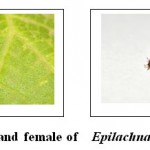 |
Figure 2: Male and female of Epilachna chrysomelina Click here to View figure |
Eggs
Found that for different temperatures and relative humidity significant impact on the growth and reproductive capacity to produce generationsE. chrysomelina,where the female lays her eggs on the body mass of an average of 27.8 ± 2.3 eggs on the bottom surface of the paper, where production times vary and reproduction between the months of the year.
Increasing reproduction and laying eggs in the periods of the month of February, March and April, while at least gradually in the months of April, May and June and disappear egg masses in the month of July and August because of the high temperature and low humidity from the normal rate.
The female lays her eggs on the leaves or large peripheral protected by mucous secretions in the absence of older leaves, they put it on solid objects, the egg spindle with an average length of (0.89 ± 0.025 mm) and the average age of the egg (7.14± 0,547) a day Fig. (3 and 4).
Larvae
E. chrysomelina be voracious feeding on the leaves of the plant-year-old firstTo a length of about 1 mm and then soon grow rapidly. Larvae feed on the leaves of the plant in the early stages of its growth, especially the lower surfaces of the paper, where she works on crop damage and destruction.
Body larva contains a large number of thorns black complex in part, dorsal and without the abdominal area of thorns (form 213) (Fig. 3 and 4) and the body of the larva amount of average length (9,2 ± 0,226 mm), and takes the larva grow to turn into a phase that followed average (8,2 ± 0,836) days .
Pupa
larva turning to a pupa is a stage that comes before the advent the adult, where the larva turn into a pupa Average (6 ± 0,707) days and be deliberately inert on adhesion papers or on plant stems and branches through the abdomen Fig. (4).
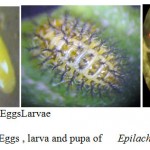 |
Figure 3: Eggs, larva and pupa of Epilachna chrysomelina Click here to View figure |
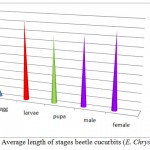 |
Figure 4: Average length of stages beetle cucurbits (E. Chrysomelina ) Click here to View figure |
The Effect of Temperature and Air Humidity on the Numerical Abundance of Beetle Cucurbits
The results of statistical analysis Simple Correlation Coefficient Table (1) showed that there is relationship and highly significant (P = 0.01) between the air temperature and the number of eggs, and the presence of a significant relationship at the level (P = 0.05) between the humidity Fig.(5 )
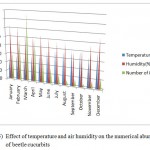 |
Figure 5: Effect of temperature and air humidity on the numerical abundance of beetle cucurbits Click here to View figure |
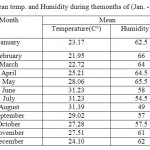 |
Table 1: Mean temp. and Humidity during the months of (Jan-Dec-2009) Click here to View table |
The Effect of Temperature and Humidity on the Female Oviposit Egg Masses
The number of egg masses that have been collected during the months of January to June and the amount of eggs that hatch with an indication of the average temperature and humidity during thesemonths. It is noticeable that the greater the average temperature and the average moisture content, the lower the number of eggs produced.
There is a correlation moral strong between the quantity of eggs produced and average temperatures, as the value of simple correlation coefficient (r) calculated at the level (P = 0.01) (0.92668) which is greater than the value scheduled (0.9170) at the same level and degree of freedom.4
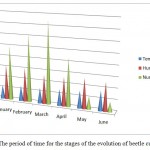 |
Figure 6: The period of time for the stages of the evolution of beetle cucurbits Click here to View figure |
The results of this study showed that the length of E. chrysomelina steady with an average length of the adult ( 8,75 ± 0,082 )mm
This number indicative of the length fairly recently from insects lengths Coleoptera where recorded lengths up to 10 mm( Perry and Roitberg, 2005 )
Cucurbits beetle as in full development insects going through four stages (egg, larva pupa the adult) such as coccinellidae (Dixon, 2000)
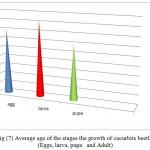 |
Figure 7: Average age of the stages the growth of cucurbits beetle: (Eggs, larva, pupa and Adult): Click here to View figure |
The results of the current study, it was observed that female beetle cucurbits laid egg masses, which range between 25 ـــ 30 eggs in environmental conditions suitable, and stated that insects coccinellidae put eggs in her lifetime approximately 500 eggs, ( Talor, 2000 ). found in this study that the egg beetle cucurbits tend to yellow and ranges Average length of ( 0,89 ± 0,025 ) and spindle-shaped, and pointed out that the length of the egg up to 1 mm in most of coccinellidae and is considered the Mexican bean beetle is the closest are the current insect in terms of morphological characteristics (Dixon, 2000).
The average age of the egg in cucurbits beetle ( 7,14 ± 0,547 ) day and the average age of the larva ( 8,2 ± 0,836 ) day and average age of pupa (6 ± 0,707) days and beetles coccinellidae up the age to 14 eggs a day appear to live larvae of 2, 5 weeks ( Hoffman and Fredsham, 1993 ).
And pupa in coccinellidae beetles average age of 7, 10 days ( Mahr,1996 ) E.chrysomelina have the ability to choose the right place to lay eggs, where if you can not find terminal leaves or large size, they put it on the hard places, and a female coccinellidae choose the right place to lay eggs( Thompson and Pellmyr, 1991)(Ballhornet al ., 2010).
There is obvious effect of the factors of the environment through the daily average temperature and humidity on the appearance of insects cucurbits of food daily in the field and its diversity, the results showed the extent to which these insects environmental variables where the highest density of numerical in the months of February and March, April and an average temperature equivalent to 23 C° and humidity upto 75% and recorded the lowest density in the months of August and September and October, where high temperatures average 36 C° and 35% humidity.
Reproduction properties in the Mexican bean beetle affected by variables of temperature and humidity, the higher the temperature less than the production of egg masses and thus less density numbers of insects (Omkar et al ., 2009).
Observed a significant correlation between the number of eggs produced by female beetle cucurbits and humidity, and there is a strong significant correlation between the quantity of eggs produced and high temperatures, and these results agreed with many of the researchers, That the fixed temperature affect growth and reproductive capacity of the CoccinelleMndecimpunctata beetle where he pointed out that the temperature of 25 – 30 C° is the best and most suitable for the development of these predatory beetles ( Abdel- Rahman, 2005 ).
References
- Abdel-Rahman, Mohamed ( 2005 ). Influence of constant temperatures on the development, and reproductive potential of the ladybird beetle, Coccinellaundecimpunctata L. ( Coleoptera : Coccinellidae ). 3rd International Conf. on IPM role in Integrated Crop Management and Impacts on Envi. And Agr. Products, 26-29-Nov. 2005, Geza ,Egypt.
- Ballhorn, D. and R. Leiberei ( 2006 ). Oviposition choice of Mexican bean beetle ,Epilachnavarivestis, depend on host plants Cyanogenic capacity. J. Chem. Ecol. Vol.
- Ballhorn, D. J. ; S. Kautz; R. Lieberei ( 2010 ) . Comparing responses of generalist and specialist herbivorous to various cyanogenic plant features Entom. ; Vol. (134), iss. (3) ; pp.245 – 259 .
- Dixon AFG.2000. Insect Predator – prey Dynamics : Lady bird Beetles and Biological Control. New York: Cambridge Univ Press. ix + 257 p
- Hoffman, M.P. and Frodsham,A. C. ( 1993 ). Natural enemies of vegetable insect pests . Cooperative Extension, Cornell University, Ithaca, NY.
- Lapointe, S. L. ( 2000 ) . Thermal requirements for development of Diaprepesabbrivatus( Coleoptera: Curculionidae ) . Environ. Entomol. 29: 150-156.
- Map-of-plant pests, (1980). Distribution Maps of Plant Pests(NO.June)Map 409, Wallingford,Oxfordshire,OX 108 DE,UK.
- Map-of-Pests,(1992). Distribution- maps – of pests nos 57,82,182,296,109,529,530,531,532manyre 56 Queen gat. London SW 75 JR, UK .
- Myers, J.H. ( 1985 ). Effect of physiological condition of the host plant on the ovipositional choice of the cabbage white butterfly, Pierisrapae. J. Anim. Ecol. 54: 194-204.
- Omkar C. ; S. Rastogi ; P. Pandey (2009). Effect of temperature on reproductive attributes of the Mexican beetle Zygogrammabicolorata( Coleoptera: Chrysomelidae ). Inter. Jour. Of Tropical Insect Sci. ; 29, pp.
- Perry, J. and B. Roitberg ( 2005 ) .Ladybird mothers mitigate offspring starvation rik by laying trophic eggs.Behavioral Ecology and Sociology 58: 578-586.
- Talhoq, A.S. (1982) Applied Zoology in Saudi Arabia, Anote on the Entomophagous Insects . Fnuna and Saudi Arabia , 4: 525- 531.
- Talor, E. C. ( 2003 ). Cellulose digestion in a leaf eating insect, the Mexican bean beetle ,Epilachnavarivestis . Department of Biology, Univ. of New Mexico , Albuquerque, NM87131, USA.
- Thompson J. N. and Pellmyr, O. ( 1991 ). Evolution of oviposition behavior and host preference in Leidoptera. Ann. Entomol. 36 : 65-89.
- AL-Digail S A, Ahma I A, Mahyoub J A. Effect of Temperature and Humidity on the Population Abundance of Spotted Oriental Cucumber Beetle Epilachna chrysomelina (F.) (Coccinellidae : Coleoptera) In Al - Qunfudah Western Saudi Arabia. Curr World Environ 2012;7(1):07-12.






